|
Publications Available for Download
Stewart Ash, an independent subsea telecommunications consultant with a career spanning over 45 years, has also written
extensively on the history of the industry. Because of the current interest in Enderby's Wharf as the site is being redeveloped, Stewart has recently undertaken extensive research into both the communications history of the site and the history of the family for whom it is named. The results of that research are presented here in the form of two fully-illustrated booklets in PDF format:
The Eponymous Enderbys of Greenwich (3MB PDF)
The Story of Subsea Telecommunications and its Association with Enderby House (3MB PDF)
These booklets may be downloaded for personal study and research or educational use. They may
not be copied and/or printed, in part or in whole, for any other purpose.
—Bill Burns, 20 October 2015
|
Enderby House Status
As of June 2014 (see photos below) Enderby House and the cable gear on the adjacent wharf had a very uncertain future, and in the years since then there had been little progress until fairly recently.
Due largely to the efforts of a local group which was formed to publicize this sad situation and to work with Greenwich Council and the site developer towards the preservation of Enderby House and the wharf, the future of the building is now assured. As of July 2018 restoration is under way and an outdoor plaze with a cable history theme is under construction.
More information, news, and contact details are at the Enderby Group website.
This January 2016 article on the A London Inheritance website places Enderby Wharf into context with the industrial area surrounding it, now being extensively redeveloped.
As of early 2019, although the final use of Enderby House is not yet certain, the building has been restored, and Lay Lines, an art installation representing the history of subsea cables has been constructed in the plaza.
More information on the status of the property may be found at the Greenwich Industrial History Society's blog. |
Established in the 1700s, the industrial area on the
east side of the Greenwich marsh had expanded down river by the early
1800s. The site on which a gunpowder store had originally stood was acquired
in 1829 by the Enderby family, Bermondsey tanners who had made money from
a white lead manufacturing process and then married into the whaling trade.
On this site in Greenwich, less than a mile from the
town centre, the Enderbys built a ropewalk (a long work area used for
making ropes) and a factory for making sails and cordage, Enderby's Hemp
Rope Works. On the riverfront they built Enderby House, dating from the early 1840s, although the exact date of its construction is not known. A tithe map of 1840 shows the site with its long ropewalk, but does not yet include the house; a newspaper report of a fire at the site in 1845 reports damage to the house, so it must have been built some time in the intervening five years.
In the 1850's the site was bought by Glass Elliot, a pioneering
company in the the new submarine cable industry, and here the first Atlantic
cable was made. Submarine cables were made at Enderby's Wharf until 1975,
and part of the site is still in use today by its present owner, Alcatel Submarine
Networks.
For a more detailed history of the site, see Allan
Green's article: 150 Years
Of Industry & Enterprise At Enderby's Wharf and this 1949 article on Enderby House from the Telcon house magazine.
|

Location of the Telegraph Construction
& Maintenance Company's
works at
Enderby's Wharf on the Greenwich Peninsula,
a site of approximately
16 acres
|
|
Google satellite view of the site
Zoom out to see the general location
|
|
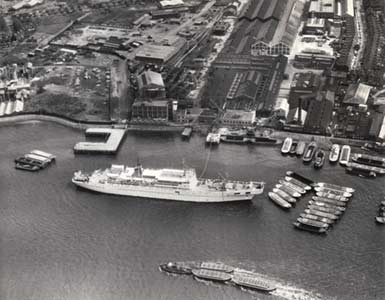
This aerial view of Enderby's Wharf
in 1965, looking eastward from the river towards Marsh Lane, shows the
factory buildings, Enderby House, and cable being loaded
on to CS Mercury
[see detail below]
SCL publicity photograph dated 23 August 1965; Aerofilms image number A150430 marked on the back of the print.
Britain from Above has a series of aerial views from 1946 taken in the opposite direction.
|

[1980s] Looking up-river from Enderby's Wharf
Image courtesy of David Watson |
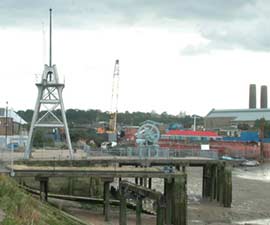 |
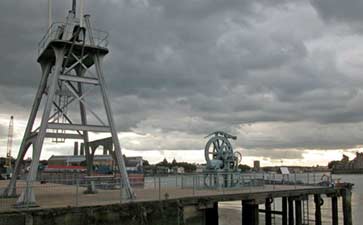 |
[2004] The cable machinery at Enderby's
Wharf, looking
up-river from
the east bank of the Thames. |
|

Detail of the 1965 photograph showing
the machinery in
use, moving cable out from the works and on to CS Mercury
|
 |
 |
| [2004] Close-up views of the cable
holdback machinery |
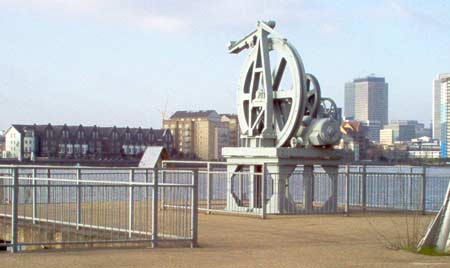
[2007] Cable holdback machine
Image courtesy of David Watson |
|

|
 |
The Wharf was renovated
for the Millennium, but vandals and neglect have quickly
taken their toll. These descriptive plaques are weathered and paint-sprayed. |
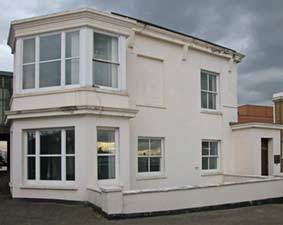 |
 |
| Two views of Enderby House in 2004,
built in the 1830s and now a listed building |
| |
2009 Update

Despite its listed building status, the owners of Enderby House are doing little to maintain it. This photograph taken by David Watson in 2009 shows very obvious deterioration in the five years since my photographs above. |
| |
May 2011 Update
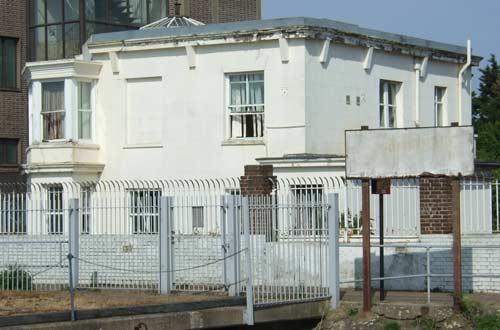
In May 2011 Enderby House is now far worse. Most windows are broken, the door is hanging open, paint is peeling, the grounds are unkempt and littered, and the building is in generally poor condition. |

|
| |
June 2011 Update

After seeing the deplorable condition of the building, I emailed Rebecca Duncan, the Senior Conservation Officer at Greenwich Council. She immediately took steps to require the site developer to secure the building. David Watson's June 2011 photograph above shows the present condition. |
| |
August 2012 Update

Sadly, nothing good happened in the following year. This August 2012 photograph by The Greenwich Phantom shows further deterioration; the door is unsecured and the property is open to vandals.
More information in this blog post
Image copyright © 2012 The Greenwich Phantom
and used by permission |
| |
April 2014 Update

The house has deteriorated even further, and is now covered in graffiti. Demolition is proceeding all around the building in preparation for the redevelopment of the site.

|
| |
Late May 2014 Update
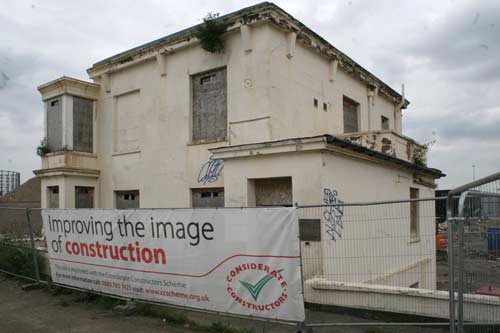
A view of the west side of the house. Demolition is complete, and the site is being prepared for the new construction. The remaining Alcatel-Lucent factory can be seen in the distance.

The two images above are courtesy of Alan Burkitt-Gray |
| |
October 2014 Update
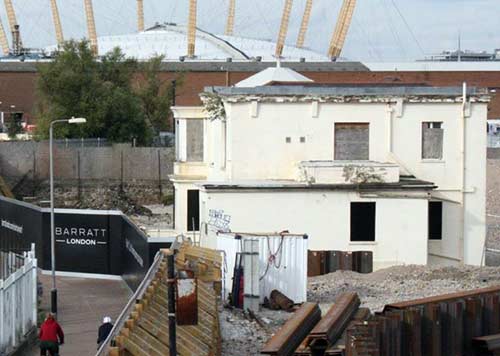
The construction site now has a fence separating it from the Thames Path. The condition of the building remains unchanged.
Image courtesy of Alan Burkitt-Gray |
| |
|

"The green water
of the Thames today laps freshly-carved steps depicting the rich
industrial heritage of the Greenwich Peninsula. The Enderby Wharf
Ferry Steps are now owned by telecommunications giant Alcatel and
their refurbishment was an initiative of Carol Kenna from Greenwich
Mural Workshop. The official opening took take place in September
2001.
"Historically, the
steps were used by the ferrymen who rowed crew out to the cable
ships. The new steps were carved by Deptford-based sculptor Richard
Lawrence, funded by the environmental regeneration charity Groundwork,
Alcatel and Greenwich Council."
[from Carving
out history: The regeneration of the
Enderby Wharf Ferry Steps, by Berni Cunnane
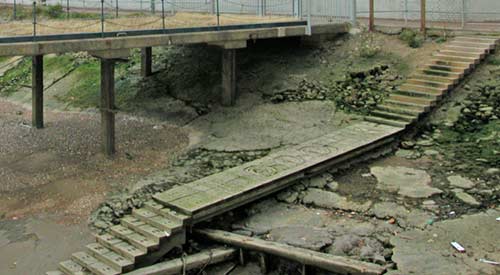
The steps seen from the wharf
|
|
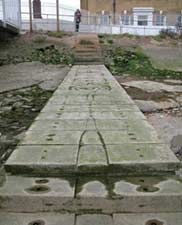
Looking up to the bank ...
|

... and down to the river
|
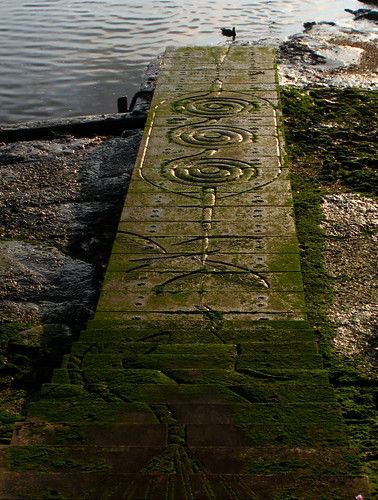
Another view of the Enderby Wharf ferry steps,
by Adrian Mars |
The Greenwich Phantom published an update on the steps in August 2013.
|
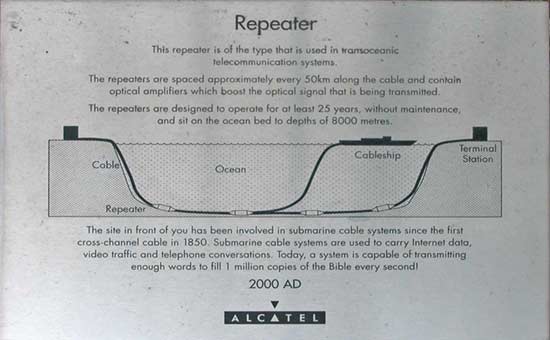
This repeater is of the
type that is used in transoceanic telecommunications systems.
The repeaters are spaced
approximately every 50km along the cable and contain optical amplifiers
which boost the optical signal that is being transmitted.
The repeaters are designed
to operate for at least 25 years, without maintenance, and sit on
the ocean bed to depths of 8000 metres.
The site in front of you
has been involved in submarine cable systems since the first cross-channel
cable in 1850. Submarine cable systems are used to carry Internet
data, video traffic and telephone conversations. Today, a system
is capable of transmitting enough words to fill 1 million copies
of the Bible every second!
2000 AD
ALCATEL
|
|
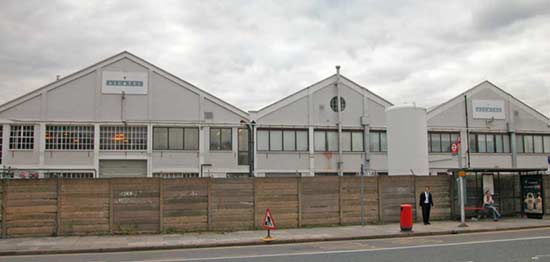
Alcatel viewed from Marsh Lane
(see
map above)
in 2004,
looking west towards the river
|

Above: Aerial view of Telcon from Marsh Lane, circa 1930.
Looking west towards the river
Thanks to Jim Jones for supplying these images |

Telcon power cable shop, SW elevation, 18 May 1937 |

Telcon power cable shop, NW elevation, 18 May 1937
Jim Jones believes that this area of the Telcon site
was destroyed by German bombs during Workl War II |
For an inside view of cable
making at Enderby's Wharf, see
Jim
Jones - Cable Work at Greenwich: Telcon, STC, & Alcatel
|

